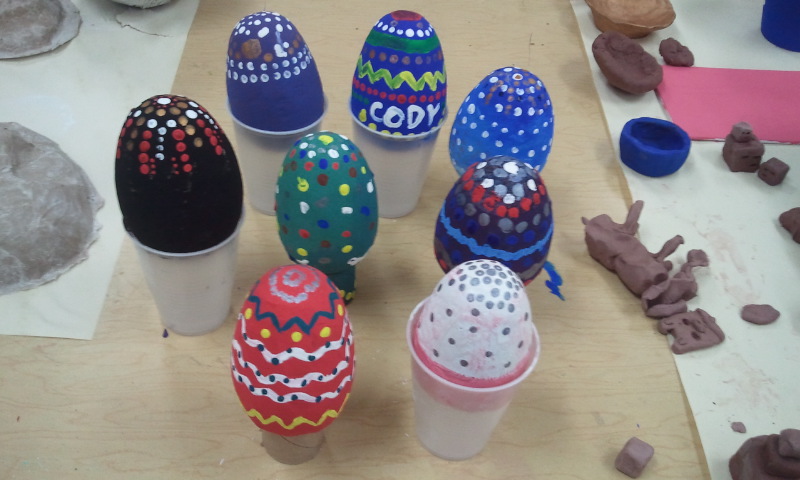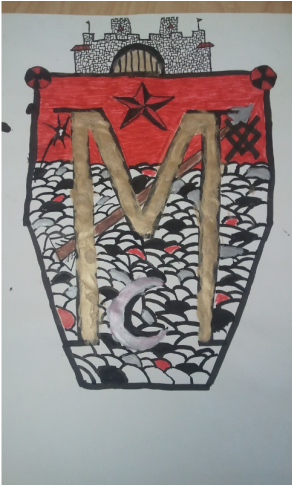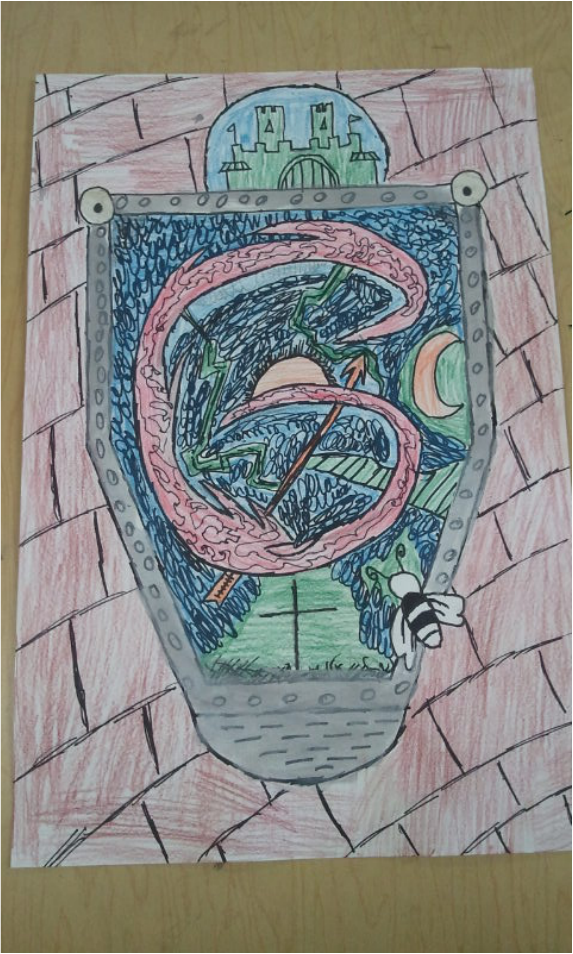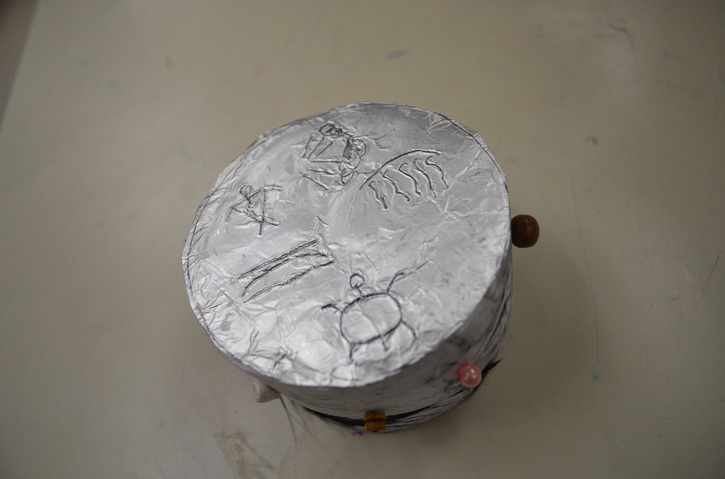|
I decided to create two summer art classes that were each a week long through Community education in my district. The first class was called "Art Around the World" and featured projects such as a chinese lantern, making didgeridoos out of PVC pipe, and multicultural paper mache masks. The second class was called "Arts & Crafts Camp" and I definitely think this class was my favorite. The Arts & Crafts camp really let student's imaginations run wild and create some really cool art! Each class included students from the ages of 9 to 13. If you've never taught a community ed art class before, you should know it's a blast! No tests, no standards, just a room full of art supplies and enthusiastic students. For any other interested art teachers out there, I included the schedules for each class's days below for your reference. Art Around the World Day One- Mexican Folk Art terra cotta pots & Paper mache mask Day Two- Australian Didgeridoos made out of PVC pipe with a beeswax mouthpiece Day Three- African Adinkra printmaking on t-shirts Day Four- Ukrainian painted eggs & Russian architecture metal tooling Day Five- Chinese Calligraphy lantern & Free Art Time Arts & Crafts Camp Day One- Cardboard Challenge & Leather tooling/stamping Day Two- Travel Posters & Clay food Day Three- Dada-inspired lamp & Drawing to Music Day Four- Metal tooling & painting clay food to look realistic Day Five- Junk Sculptures & Hot glue fancy frames Check out the photos below to see all of the cool art we created & tips for doing the same! 
Metal tooled tiles. Cut 38 gauge aluminum metal into 6"x6" squares. The foil I purchased was from Dick Blick and came in 12"x25 ft rolls for around $16. Fold a 1/2" over on each side to prevent injury. Use a blunt pencil to tool designs. I had students draw their design on scratch paper first and then put their paper over the metal and traced to transfer. Use colored sharpie to highlight the areas you tooled. You can also turn the metal over for an embossed effect.

The lamps were created using pint size mason jars, socket light switch kit ($3.99 at Menards or other hardware store), modge podge, tacky glue, and an assortment of magazines and newspapers. Students decoupaged their cut outs onto the lamp using the tacky glue and modge podge. Some students used shredded up tissue paper and decoupaged the tissue paper to the inside of their lamp for a cool background. We used a nail to pound a hole into the lid and then used tin snips to cut a larger hole (this was mostly done by me due to sharp edges). Then the sock was inserted into the hole and a nightlight bulb placed inside that! The original project idea was for a hanging lamp, but some students designed their lamp to sit on a table. We simple cut a small notch in the lid for the cord, so the lamp could sit level. This was probably my student's favorite project!

A cool way to work on the didgeridoo was actually discovered by accident! We placed didgeridoos on sturdy, over-turned chair legs so we didn't have to worry about smearing paint. 1 1/2" schedule 40 PVC was used and cut in a variety of lengths from 3.5 ft to 5.5 ft. Students sanded the PVC and then painted at least two coats of acrylic paint onto the PVC. Next, students took q-tips and paint to create aboriginal-inspired dot paintings on their didgeridoo. The last step was adding melted beeswax to the top to create a mouthpiece and a few beads/feathers for decoration. This project was student's favorite from the Art Around the World class!
0 Comments
 What a crazy project, but so much fun! The last project for my 6th graders involved creating a medieval art inspired coat of arms. We talked about illuminated letters, heraldry symbols, and characteristics of Medieval art. The kids really seemed to like this project. We focused on lines and patterns to create an interesting background for our coat of arms. Students were asked to add a letter to their coat of arms. Some students chose graffiti style letters, while others went the more traditional route. We started running out of time, so not all students got to color in their coat of arms. But even black and white looked cool! I had a huge pack of gold leaf laying in my craft room and allowed some students to add the gold leaf. It was pretty tricky (next time I would use a gold paint pen instead) but the kids were amazed. They were convinced the gold leaf would make their artwork very valuable. ;)
Well, my first glaze fire was a success! These Amaco F-series glazes sure are forgiving. We went through 10 bottles of glaze! Since we were so low on clay, my original plan for students to create a plate had to be sized down. Instead, I had students create a small 4-5" medallion and create a design using radial symmetry and texture. We looked at other Islamic tiles for inspiration and even took a virtual tour of the Blue Mosque in Turkey. The tour got a lot of enthusiasm! I gave students a choice on how they wanted to use their medallions. Some students chose to create a wind chime, others chose to make them into a necklace or to hang on the wall, and some students said they'd like to use their medallions as a coaster or candle holder. Some students even included Arabic writing in their designs!  Students also had one day to create a simple pinch pot with a face using addition (slipping & scoring method). I had students poke a hole in the bottom to turn them into mini flower pots. We are planting chia seeds in the pots when we come back from Spring Break. We'll let them grow in my window for a week, and then students get to take home a "living sculpture"!  Well the American Indian art unit is complete! We made birchbark boxes from cardstock paper with printed birchbark textures. I had students use beads, feathers, and leather scraps to decorate their boxes. Some students got a bit over-excited with the decorations, but some boxes turned out so cool! We did a compare/contrast between the artist Bobby Wilson and traditional Ojibwe art. We also did a graffiti write on what they knew already about Ojibwe art. In total, the unit took about 5 (50 min.) class periods in total for most students to finish. Some students really struggled with assembling their boxes, but most seemed to get it. One thing I added to this lesson was a tooled metal lid. I had students do some beginner metal tooling in heavy duty aluminum foil. Students were asked to tool with a blunt pencil at least three Ojibwe symbols into their aluminum foil. We cut and glued the foil to the paper lid. We also talked about the differences between traditional and contemporary Native American art. This led to a great discussion on how stereotypes can hurt people and what kind of stereotypes we all experience on a daily basis. It was pretty powerful, and overall, a fun project!  Minnesota Birch trees Minnesota Birch trees I have struggled and struggled to find a great lesson to meet the MN visual art standard: 6.1.3.5.1 1. Compare and contrast the connections among visual artworks, their purposes, and their personal, social, cultural and historical contexts, including the contributions of Minnesota American Indian tribes and communities. I think I've probably spent an entire week trying to figure out a lesson that wouldn't cost too much or wouldn't take a month to finish. I stumbled on a great instructable on how to construct a round box. I thought this would be a great activity for students to do out of birch bark and tie in with Ojibwe art and culture. Only downside, with 250 students, I'd need A LOT of birch bark. So that's when I came up with my faux birchbark. I used charcoal pencil on white paper and created my own birchbark texture. I added a little coffee stain and some smudging, and voila! "Birchbark" paper. I decided to make a template for the box in advance to prevent any issues with measuring or cutting....saving paper! The template isn't perfect, but it works pretty well. You can download my template below: Download the Birchbark box template for $3.00 from TPTI haven't taught this lesson, as I plan to do so next week. I am hoping to start off by having students do a graffiti write of all they know about Native American art and culture. This will give me an idea of what we should cover (what students already know and what needs clarification). I am going to show students some images of the Jeffers Petroglyphs located in Minnesota and we might even compare/contrast with Egyptian hieroglyphics. Next I will have students create a design on the lid of their box using Ojibwe symbols. I might even have them do a glue resist-- so many choices! Once the design is done, we will construct the boxes. I am having my template printed on ivory cardstock paper to make it more sturdy, but printer paper seems like it works too. I will be sure to make an update post about how this lesson goes. I think this will make a great end of semester project. Examples of Ojibwe Birchbark Boxes |
Mrs. QuamThis is my 11th year teaching art & graphic design! I have taught middle school for 2 years and high school for almost 5 years. I truly enjoy working with students on a daily basis. I also enjoy teaching real-world skills such as problem solving, using technology, and the power of teamwork and collaboration. My joy is sharing my passion for art with others! Archives
March 2024
Categories
All
|
Photo from Rob Qld


































 RSS Feed
RSS Feed

